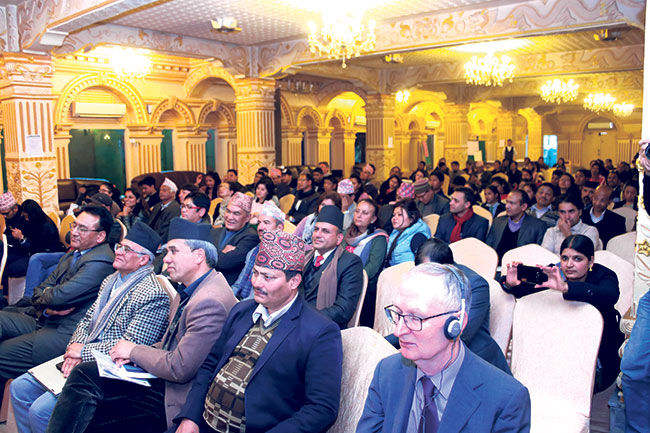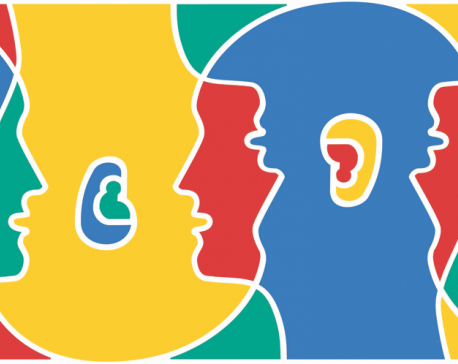
OR
advertorial
Language in education.
Recognizing multilingualism in education
Although Nepal has rich linguistic and cultural resources, educational discourses and practices hardly recognize and capitalize on them for quality learning. Contrary to the evidence that shows strong cognitive, academic and social importance of multilingualism in education, schools, both public and private, are increasingly adopting English as medium of instruction (EMI) policy.
 However, whether this policy contributes to quality learning of children, who speak languages other than English at home and in the community, is questionable. British Council’s position paper on the English language in basic education, attempts to address this question and focuses on why it is not desirable to adopt EMI policy in the early grades. Informed by a deep analysis of cases from multilingual countries, the report makes the stance of British Council on language education policy clear: EMI for the early graders whose first language is not English creates a barrier for quality learning.
However, whether this policy contributes to quality learning of children, who speak languages other than English at home and in the community, is questionable. British Council’s position paper on the English language in basic education, attempts to address this question and focuses on why it is not desirable to adopt EMI policy in the early grades. Informed by a deep analysis of cases from multilingual countries, the report makes the stance of British Council on language education policy clear: EMI for the early graders whose first language is not English creates a barrier for quality learning.
Although this claim has long been discussed by researchers in second language studies, this report is quite relevant for two reasons. First, as a position paper, this report highlights British Council’s commitment towards equitable, inclusive and quality education by recognizing linguistic diversity as resource for learning. This commitment is particularly important “to prevent misconceptions arising about the British Council seeking to promote English over mother tongue” (p. 4).
As stated in the report, British Council, the organization popularly known as the promoter of English globally, embraces the fact that “children’s participation in well-designed multilingual programmes underpins learning in all subjects, including English, through use of the mother tongue or a familiar indigenous language” (p.3). With this position, British Council not only acknowledges the substantial body of knowledge that shows the need for multilingual education for quality learning, including English, but also, and perhaps, more importantly, communicates its stance that multilingualism is not a problem rather a resource for helping children learn creatively and effectively.
Secondly, the report focuses on educational aspect (i.e., how early grade children learn effectively) to analyze impact of EMI policy on students’ learning in low-income countries. Adopting the evidenced-based approach, the report critiques a deeply rooted misconception that considers EMI and teaching English as subject (EaS) as similar. In low-income and multilingual countries (e.g., Nepal and India), EMI policy is increasingly adopted with an assumption that children, who speak languages other than English at home, learn better English if they are taught academic content (e.g., Social Studies, Mathematics and Science) solely in English. However, as robust research has consistently found , teaching early grade children in a language they are not fully competent is detrimental to learning both second language and academic content.
As the report highlights, “there is little or no evidence to support the widely held view that EMI is a better or surer way to attain fluency in English than via quality EaS” (p. 3). Therefore, British Council clearly states that the organization is not supporting the practice of the early introduction of EMI policy. However, they will continue to support and promote high quality teaching of English as a subject.
Overall, British Council does not just make its position on language in education policy explicit through this report, but also recommends for “well-designed multilingual programmes” to strengthen effective and equitable learning of all subjects, including English. To achieve this, all concerned stakeholders, including parents, teachers and communities, should work together to create a multilingual educational space where students from all linguistic and cultural backgrounds see themselves as source of knowledge, which they can use, with the help of teachers, fully and creatively in learning processes.
NIITE trained over 7000 teachers

Vaishali Pradhan
Programmes Manager – English
What has British Council done for improving English Language Teaching (ELT) in Nepal?
British Council has been working in Nepal in the areas of English language teaching and learning and wider education and skills for the past 60 years. We have done many projects in partnership with the National Centre for Education Development (NCED) to support and promote the continuing professional development of teachers.
We have examples of successful projects like English for Teaching, Teaching for English (ETTE) and ETTE+ which we delivered in collaboration with District Education Offices in different districts. From 2008 to 2016, more than 800 English language teachers were trained on language and pedagogical skills.
We believe that in order for training to be implemented at classroom level, it is essential to have a cadre of well-trained teacher trainers who are not only able to plan and deliver, observe others and give constructive feedback but are also reflective practitioners who take responsibility for their own professional learning as well as supporting teachers with theirs. Over the years we have been able to build the capacity of over 175 teacher trainers, many of whom are still working as government roster trainers for various projects. We are now working closely with NCED to develop their ELT training curriculum and will be piloting it in a few districts very soon.
Which level of teachers does British Council focus on for its teacher training initiatives? What has been the impact?
Our past ELT projects have been for teachers at primary level however we’ve gradually shifted our focus towards teachers from grades 6 and above. The level of teachers really depends on the content and structure of the project being delivered. The ETTE project had a major focus on developing the English language proficiency of the teachers themselves whereas ETTE+ had a balance between teaching skills and language skills. Project evaluation reports have shown major impact in both these areas with teachers feeling confident to use English more widely as well as being capacitated to use effective communicative teaching techniques in their classrooms. I’ve been to many schools myself during the implementation phases and have witnessed active and engaged classrooms.
You recently concluded a project that supported teachers from English Medium Schools. How did the project go and what were the achievements?
Our most recent project was the National Initiative to Improve Teaching in English (NIITE) which was developed and implemented in partnership with NCED. It came as a result of a large number of teachers requesting support from NCED as their school had changed to EMI but they felt ill-equipped to deliver their lessons.
The objective of this project was to build teacher confidence in their own knowledge and use of English in the classroom and to build their awareness of language supportive approaches for teaching in English Medium contexts. Over three years, the project trained over 7000 teachers from grades 6-8 and build the capacity of around 120 trainers. Moving away from a traditional style of teacher training, NIITE had a strong focus on continued support for teachers using self-access materials, online support, classroom observations and feedback and the use of TeachApp (mobile app).
As a result, a huge impact was seen on teachers using language supportive approaches in their classrooms with Nepali increasingly being used in a deliberate informed manner to facilitate learning, as described and encouraged by the training. Students liked their greater participation in lessons and wanted to learn to function in English, though often that was difficult. So, the main achievements we see are in the model of training and the ability of teachers to directly apply their training in the classroom. However, we also see clearly the significant challenges of schools shifting to EMI in this ad hoc, unplanned way. In the future we would like to see the NIITE model used to support schools and teachers wanting a planned transition to English Medium Instruction.
What level of achievements have you seen on students studying in EMI schools?
That’s a very good question but very hard to answer because until now there is very little data about the learning achievements of students from EMI schools in Nepal. It is only very recently that the Ministry of Education started collecting data to look at this. A few small scale studies have been done in Nepal but the findings are not conclusive or representative.
Internationally there is a lot of very strong evidence that shows that millions of children are not achieving learning goals in school because they are not being taught in a language they understand. Going hand in hand with this, is an equally strong evidence base that clearly shows the young children learn best in a familiar language, ideally a home language or onethey have regular exposure to outside the classroom. Another thing we know is that if you want to see improved achievement in English proficiency, then being taught it well as a subject is more likely to produce good results.
Many schools here have changed into EMI following parental demand and the pressure of increasing student numbers. This demand for English is legitimate but the answer to this isn’t necessarily English medium. There is often a misconception that being good at English is synonymous with English medium instruction. However, there is little or no evidence to prove this. Evidence based research show that in low and middle income countries, implementing EMI at primary level can actually have a negative impact on the learning outcome of students.
Therefore we believe that teaching English as a subject well with trained English teachers can be the answer to parental demands. And if schools do wish to move to EMI at upper primary, a planned transition needs to be in place where the ‘readiness’ of the school is assessed in terms of teachers’ capacity in English, pedagogy and access to good English resources.
Teaching in mother tongue to improve learning

Article 31 of the Constitution has ensured the right to education. It guarantees the right to learn in mother tongues. It has also entrusted the Language Commission with the responsibility of exploring the possibility of using mother tongues. The right to get education in mother tongues has been enshrined in the law.
However, the guardians want that their children be taught in the English language. The law does not prescribe separate mediums of learning for public and institutional schools. Therefore, the right of every child to learn in his/her mother tongue has been guaranteed in the Constitution. However, the institutional schools have adopted English medium and the public schools, taking their cue from the institutional schools, have started teaching in the English language. National and international researches show that the children who get education in their mother tongues perform better and their English, too, is good.
Dr Lava Deo Awasthi, chairperson of the Language Commission, sheds light on the issues pertaining to learning in mother tongues. Excerpts:
Why has it become necessary now to make mother tongues the mediums of learning at the school level?
Not only now, we realized long ago that children should get the opportunity to learn in their mother tongues. National and international studies show that learning in mother tongues enhances the capacity of children. If we want to improve their learning, we need to provide them the opportunity to learn in their mother tongues. Researches have shown that it will help them learn both Nepali and English better. The Constitution, too, has guaranteed the right to get education in the mother tongue. We are committed to abide by the Constitution. It is necessary to teach children in their mother tongues in the schools.
But even moral and social studies are taught in English in schools these days. What do the students learn from it?
This is a result of misunderstanding. Moral and social education is a completely fundamental issue. Moral education cannot be learned in English. This is true about social education as well. Social education works only if the students gain knowledge about their societies. Social education and society are interlinked. Moreover, moral education is linked to character. These subjects are related to our own society. So, teaching these subjects in a foreign language won’t work. Social education transforms our lives and inspires us to be good. Moral education is not different. Learning in the mother tongue is also related with our cultures and social values. So, these subjects should be taught in the local language or mother tongue in schools.
We talk about teaching in mother tongues. But in institutional schools, all subjects except Nepali are taught in English. In this situation, how can mother tongues be made the mediums of teaching?
The Language Commission has already submitted a report to the government, addressing these issues. Our concern is that children should learn, whether they go to public or institutional schools. It is more important to ensure that children learn. It is meaningless if they do not learn. We have found that children do not learn even in private schools. It is necessary to teach them in their mother tongues. These issues are included in the report we have submitted to the government.
The school curriculum has a provision for teaching mother tongue/local language/ Sanskrit of 100 marks up to Grade 8. However, schools teach English instead of these subjects. What has the Language Commission recommended to the government to tackle this issue?
That’s wrong and we know that schools are doing this. We have made recommendations to the government to address this issue. Schools are misusing the provisions in the curriculum. The curriculum should be strictly implemented.
There are 123 languages in the country. Have arrangements been made to train teachers to teach in these mother tongues?
All languages cannot be taught in a school. There are different languages in different localities. The medium of teaching should be based on the locality. The commission is studying this and trying to develop a model of teaching in 8 to 10 languages. The infrastructures and facilities available in the schools will determine how to go ahead.
It seems quality education won’t be possible in the provinces and the local bodies if local resources are left unused. How to tackle this challenge?
It has two dimensions. One, we all should abide by the Constitution which has ensured learning in mother tongues. The local bodies or provinces cannot go against this constitutional provision.
Two, they should be able to manage the local resources. That should be a priority. So, local bodies must exploit resources to tap the potentials of children for the development of nation.
You May Like This

State-Minister for Education Adhikari bats for education reform
CHITWAN, Sept 27: State-Minister for Education, Sheshnath Adhikari, has given a clarion call to the concerned authorities to bring about... Read More...

Rights of every student to quality education secured: Education Minister Shrestha
KATHMANDU, June 14: Deputy Prime Minister and Education Minister, Gopalman Shrestha has said that the right of every student of... Read More...

Ethnic language and English medium education
On February 1, 2015, a post appeared on Facebook. The post was by a Newar student who had lost his... Read More...





Just In
- Nepalgunj ICP handed over to Nepal, to come into operation from May 8
- Nepal to gift two elephants to Qatar during Emir's state visit
- NUP Chair Shrestha: Resham Chaudhary, convicted in Tikapur murder case, ineligible for party membership
- Dr Ram Kantha Makaju Shrestha: A visionary leader transforming healthcare in Nepal
- Let us present practical projects, not 'wish list': PM Dahal
- President Paudel requests Emir of Qatar to initiate release of Bipin Joshi
- Emir of Qatar and President Paudel hold discussions at Sheetal Niwas
- Devi Khadka: The champion of sexual violence victims



_20240423174443.jpg)










Leave A Comment